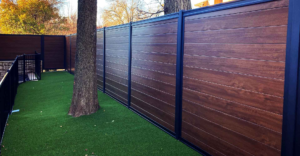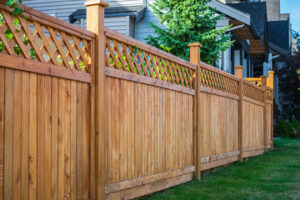Privacy Fence is one of the best ways to make your backyard feel like a secluded escape. It helps keep children and pets from wandering off and deter trespassers.
It also makes your property more secure, as it prevents people passing by from being able to see any valuable items you might have.

Privacy is one of the most important aspects of an individual’s life. It ensures a person’s autonomy and protects their dignity and self-worth. Privacy can also help people form and manage appropriate relationships, reducing the risk of abuse. The lack of privacy can cause mental stress and depression, and it can also impact an individual’s ability to function in society. The importance of privacy has been recognized by various international treaties and conventions.
A privacy fence is a good way to protect your family’s outdoor space and improve the aesthetic appeal of your home. It can provide a barrier against the sun’s harsh rays and help block out street noise, making your backyard the perfect place to relax and unwind. In addition, it can protect your yard from wild animals and help keep your pets safe.
There are a variety of privacy fence styles, materials, and designs available to fit your needs. For example, a wood privacy fence is a classic option that can add a warm and inviting feel to your property. Other types of privacy fencing include vinyl and PVC, which offer a more modern look. Some of these fencing options have lattice tops that are decorative and provide privacy.
In addition to providing privacy, a privacy fence can also help protect your flower beds and garden from high winds. It can also provide shade for your patio furniture later in the day. In addition, it can help you to avoid the cold winter wind while relaxing in your backyard.
A privacy fence is a great investment for your property. It will not only increase the value of your house, but it will also protect your children and pets from harm. It will also prevent strangers from entering your backyard and causing harm to your loved ones. When choosing a privacy fence, it is important to consider the size and layout of your property. You should also know how much privacy you want and what your budget is. If you are unsure about how to find the right privacy fence for your home, ask a professional.
A privacy fence is a great way to protect your outdoor space. It not only offers seclusion but also helps to keep pets and children safe. Plus, a privacy fence can help deter burglars and other unwanted guests from entering your property.
There are many different types of privacy fences to choose from, so it’s important to know what your options are before you make a purchase. For instance, bamboo fencing is a popular option because it’s affordable and eco-friendly. It’s also durable and provides a stylish look for any home.
Another type of privacy fence is a steel slat fence. This style of fence is made up of long, thin slats that are welded together to create a solid barrier. These slats are often topped with lattice tops for added beauty and privacy. Steel slat fences are also an excellent choice for residential properties because they are strong and secure.
Wood and vinyl fences are also good choices for homeowners who want a privacy fence. They are available in a variety of styles and colors, making them a great fit for any home. Moreover, they are easy to maintain and can last for years. Some fences are even customizable, giving you the option to add gates and other custom features.
If you want to go the natural route for a privacy fence, consider planting trees and shrubs. However, keep in mind that these options won’t offer as much seclusion as a wooden or vinyl fence. Moreover, you’ll need to take care of tree roots that may damage your foundation. You should also plant the trees and shrubs far enough away from your house so that you don’t have to worry about deer.
Before you decide to install a privacy fence, it’s essential to know what your local rules and regulations are. Your neighborhood might have zoning laws that limit the height of your fence or the materials you can use. Similarly, your homeowner’s association may have its own guidelines. In addition, some towns require a permit for any fence that’s higher than six feet.
When it comes to a privacy fence, durability matters. You don’t want to spend time and money on a fence that will degrade quickly or easily. There are many durable options to choose from. For example, steel is a strong material that can withstand extreme weather conditions and still provide a beautiful aesthetic.
Aluminum fencing is also a good choice for homeowners who need a privacy fence that will last a long time. It’s a sturdy and low-maintenance material, which makes it an excellent option for backyards that feature pool equipment or other outdoor furniture. It’s also easy to install and provides a great look that will complement your garden or lawn decor.
Bamboo is another option for a privacy fence that offers style and strength. It’s a natural option that won’t harm the environment, and it looks just as nice as traditional wood privacy fences. It’s an excellent choice for yards that contain outdoor equipment like pools or hot tubs. Bamboo privacy fences are also very affordable and come in pre-assembled panels that make it simple to install.
A privacy fence can protect a home from potential burglars and keep neighbors out of one’s yard. It can also keep kids and pets from wandering off the property and getting into danger. A privacy fence can also prevent people from seeing valuable equipment and furniture on the property, such as a trampoline or pool.
Before installing a privacy fence, homeowners should check with their local city hall or homeowner’s association to find out what restrictions may apply. They may have rules on height, materials and other factors that affect privacy. Some municipalities also require a permit for fencing construction, especially when it’s higher than 6 feet.
Some privacy fences can be very expensive to build and maintain, but they can improve the value of a home. It’s important to weigh the benefits and costs before choosing a fence material that’s right for your needs. A local fence contractor can help you discover the best fencing options for your home and budget. They can also recommend non-fencing products to tie your landscaping and outdoor space together.
A privacy fence adds to the curb appeal of your home. It also helps reduce street noise and other neighborhood commotion. Depending on the height of your new fence, it can also protect flower beds and other landscaping from high winds. The privacy fence can also help keep your patio cool during the summer months, providing shade from the afternoon sun.
A basic cedar privacy fence has a simple, straightforward appearance that blends in with many yards. However, a few design modifications can make your fence stand out from the rest. A lattice fence, constructed from thin slats in an open criss-cross pattern, is another option for creating a decorative privacy fence. Although this type of fence does not provide complete privacy on its own, you can train a climbing vine to cover it for added security and beauty. Lattice fencing can also be used as a top element on a stockade or shadow box fence for a more finished look.
Brick, PVC, and vinyl fences vary in the amount of privacy they offer. While brick fences are solid and highly private, vinyl and PVC fences use slats with gaps that can reveal your backyard to neighbors. If you want a more traditional look, consider a mortared stacking-stone wall for your backyard.
A natural wood or cypress privacy fence can be a beautiful and environmentally friendly addition to your yard. However, these types of fences are usually expensive and require regular maintenance. You can also purchase pre-made privacy fence panels made from treated pine, redwood, or spruce. A pre-fabricated wood privacy fence can be installed much more quickly than a custom-built one, and it may not require as much maintenance.
